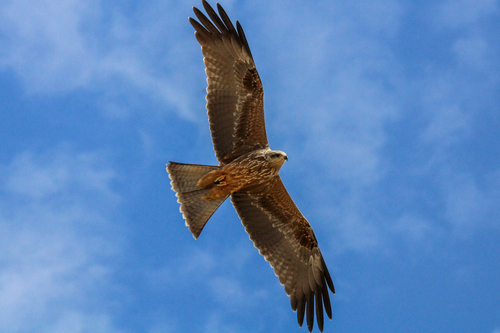
Black Kite
The Black Kite (Milvus migrans) is a medium-sized bird of prey widely recognized for its adaptability and opportunistic feeding habits. It plays a crucial role in many ecosystems as a scavenger and predator, helping to control populations of small animals and remove carrion. Unlike many raptors, the Black Kite often thrives in close proximity to humans, frequently seen soaring over urban areas and agricultural lands. While not culturally significant in the same way as some iconic eagle species, it is a familiar and often respected bird in many parts of its extensive range.
44-66 cm
Length
120-155 cm
Wingspan
Least Concern
Conservation Status
Distribution
The Black Kite has one of the largest ranges of any bird of prey, found across Europe, Asia, Africa, and Australia. It is largely absent from the Americas. Many populations are migratory, with European and Central Asian birds wintering in sub-Saharan Africa and South Asia. Altitudinal range varies from sea level to mountainous regions, although it generally prefers lower elevations.
Lifespan
Up to 24 years in the wild, potentially longer in captivity.
Black Kite's Habitat
Habitat Types
Open woodlands, Grasslands, Wetlands, Agricultural areas, Urban environments, Coastal regions
Climate Zones
Tropical, Subtropical, Temperate, Arid
Adaptations
Black Kites are highly adaptable to various habitats. Their broad wings are suited for soaring and gliding, allowing them to cover large distances with minimal energy expenditure. They are opportunistic feeders, which allows them to thrive in diverse environments, including those heavily modified by humans.
Variations
Several subspecies are recognized, differing slightly in size and plumage. For example, the *lineatus* subspecies of eastern Asia has a paler head and underparts compared to the European *migrans* subspecies. Island populations, such as those in Indonesia, may also show distinct morphological traits.
Appearance
Breeding Plumage
Generally similar throughout the year, but plumage may be slightly brighter during breeding season due to fresh feathers.
Seasonal Feather Changes
Minor; plumage becomes worn and faded before molting.
Sex Based Plumage Differences
Minimal; males and females have similar plumage.
Notable Features
Forked tail (less pronounced than in Red Kite), Dark brown overall plumage, Yellowish cere and legs, Slightly hooked bill
Diet and Feeding
Primary Foods
Carrion, Small mammals, Birds, Fish, Insects, Reptiles
Foraging Behavior
Black Kites are opportunistic foragers, employing various techniques. They soar and glide to search for food, often circling over open areas. They also perch on trees or posts, waiting for prey. They are known to steal food from other birds (kleptoparasitism) and are frequently seen scavenging at garbage dumps and along roadsides.
Specializations
Their broad diet and scavenging habits are specializations that allow them to survive in a wide range of environments. Their keen eyesight is essential for spotting both live prey and carrion from a distance.
Seasonal Diet Variations
Diet varies depending on prey availability. During migration or in winter, they may rely more on carrion and easily caught prey. In the breeding season, they may focus more on live prey to feed their young.
Behavior
Social Structure
Black Kites are often seen in large flocks, particularly during migration and at abundant food sources. They may form communal roosts outside the breeding season. During breeding, they are typically territorial, defending the area around their nest.
Communication
Whistling calls, Mewing sounds, Aerial displays, Body postures
Migration
Many populations are migratory, undertaking long-distance journeys between breeding and wintering grounds. They often follow coastlines and mountain ranges, using thermals and updrafts to conserve energy. Migration can be triggered by changes in day length and food availability.
Territorial or Group Behaviors
During the breeding season, pairs defend a territory around their nest. Outside of breeding, they are highly social and often congregate in large numbers at roosting sites and rich food sources.
Conservation
Threats
Habitat loss, Pesticide poisoning, Collisions with power lines and vehicles, Hunting and persecution, Climate change
Protection Programs
Monitoring of populations, Habitat restoration, Regulation of pesticide use, Public awareness campaigns
Local National Laws
Protected under various national and international laws, including the Migratory Bird Treaty Act in the US (although not native there) and similar legislation in Europe, Asia, Africa, and Australia.
Population Trend
Stable
Population Estimates
Global population estimated to be 6 million individuals.
Interesting Facts
Black Kites are known to decorate their nests with colorful objects.
This behavior, particularly common in urban areas, may serve to attract mates or signal nest occupancy.
They are highly skilled at catching insects in flight.
This aerial agility allows them to exploit swarming insects, a valuable food source.
They sometimes follow grass fires to catch fleeing prey.
This opportunistic behavior demonstrates their adaptability and intelligence.
In some areas, they are known as 'fire hawks' due to this behavior.
This demonstrates their opportunistic behavior when hunting.
Faqs about Black Kite
Are Black Kites dangerous to humans?
No, Black Kites are generally not dangerous to humans. They may become aggressive if their nest is threatened, but attacks are rare.
What should I do if I find an injured Black Kite?
Contact a local wildlife rehabilitation center or veterinarian. Do not attempt to handle the bird yourself, as they have sharp talons and beaks.
How can I tell a Black Kite from a Red Kite?
Black Kites have a less deeply forked tail and darker overall plumage than Red Kites. Red Kites also have distinctive white patches on their wings.
Do Black Kites mate for life?
Black Kites are generally believed to be monogamous, forming pair bonds that may last for several years or even life. However, 'divorce' can occur, particularly if breeding attempts are unsuccessful.
Copyright @ Nature Style Limited. All Rights Reserved.
 English
English